Like most things in my life, this blog post is a little late.
For my birthday my grandmother bought me the most glorious book: the Brewer’s Dictionary of Phrase and Fable. It is a thousand pages of intrigue and strange stories, folk figures and murky meanings. It is my favourite thing to lose time in, going from one root word to another.
I was however, amid the feelings of awe and amusement, slightly disheartened by the lack of lady folk between the pages. Now, as a book that centres on the English language I can hardy expect it to be an anthology of every existence, yet the missing history saddens me: we women can only exist in myth or as a muse it seems.
So I did what any consistently angry feminist would do: I started writing in my own. For instance, one little titbit of floral folklore is that violets have long been used as a symbol of secret love for lesbians and bisexual women. The tradition of gifting the flower dates back to Sappho, a poetess in Ancient Greece who wrote of her lover wearing a garland of violets. The colour violet also signifies the soul in the rainbow flag.
Anyway, the tangential point I am trying to make is that if stories and histories refuse to remember us: we must make our own. History is awash with omitted, forgotten and usurped women. We have been discarded, disgraced, had our ideas and inventions stolen or accomplishments diminished. Here is a small attempt to bring these ladies – both good, bad and brutal – back into the light.
We must learn and revise and create our own ways of being. So here is part two of my Badass Bitches of History series (find part one here), this time stretching from 1100s to the late 1700s, which celebrates ladies that resisted and endured savagery and sainthood. Both defiant and deplorable, fantastic and frightening, this read is a long-un – so buckle up.
Artemisia Gentileschi
This is one lady I have spent a long time thinking over. Artemisia Gentileschi was a one woman hurricane, equal parts resilience, revenge and talent. She converted her trauma into art and used oil and canvas to exorcise what was done to her. But ok, before I get carried away with my 500 year old lady crush, I’ll start at the beginning.
Artemisia Gentileschi was born among the frescos of Rome. She was the daughter of a famous painter who encouraged her art at a time when women were barely allowed to be educated. She started by working as his apprentice, but by the age of 17 he declared her “peerless.”
Her talent was also what sealed her fate: when she was 18, her father enlisted the help of fellow artist Agostino Tassi to help teach her perspective. During these lessons, her tutor turned abuser repeatedly raped her. As a woman now sullied by the touch of a man, Tassi promised her he would marry her, but did so to placate her while he continued his abuse. When her father found out he had Tassi arrested and she was thrown into the centre of a seventeenth century media frenzy.
Made to recount and relive details of her rape in court, Artemisia was picked apart and put on trial herself, the judge even ordering she be tortured in order to prove her honesty and virginity. Tassi claimed she was “an insatiable whore” and had midwives inspect and prod and probe her body in front of the judge to prove the existence of her other supposed lovers.
Tassi, like many powerful, male abusers today, was given a pitiful sentence. But for all the hurt there was something growing: Artemisia’s art was in metamorphosis.
Not long after the trial she began her first rendition of Judith Slaying Holofernes, a character and scene she would paint many times (in fact, her 1620 version painted for Cosimo II de’ Medici was so horrific that the Grand Duke of Tuscany hid it from view). Yet what makes this work so remarkable isn’t only her exceptional ability, but rather her interpretation. Holofernes was an Assyrian general who had come to Israel to sack the city. To defend her city and its inhabitants, she seduced him. Then, in the dead of night while he drunkenly slept, Judith and her maidservant decapitated him.
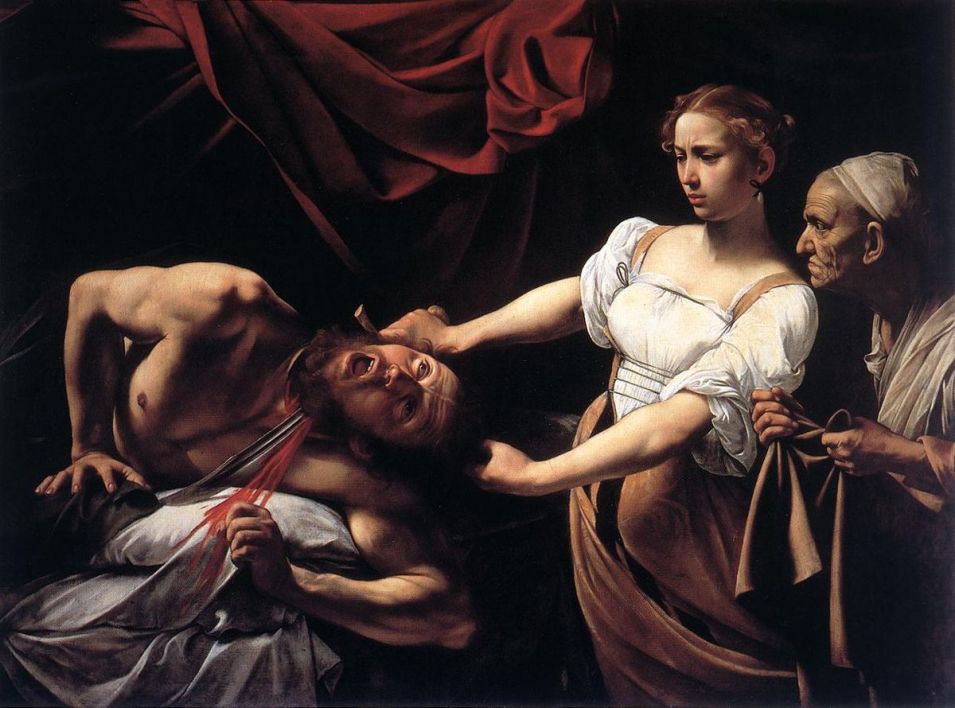
Judith has long been depicted in Baroque art thanks to her Biblical beginnings. But until Artemisia, she was always led by the ugly maid’s hand and seen as passive, feminine and ultimately powerless. Artemisia’s Judith was all guts and glory and catharsis. The painting is almost autobiographical: you can feel her rage seeping through the paint. Her anger is palpable, the brutality of the act inescapable as Tassi takes the place of the slain general, enslaved and doomed by his sexual appetite.
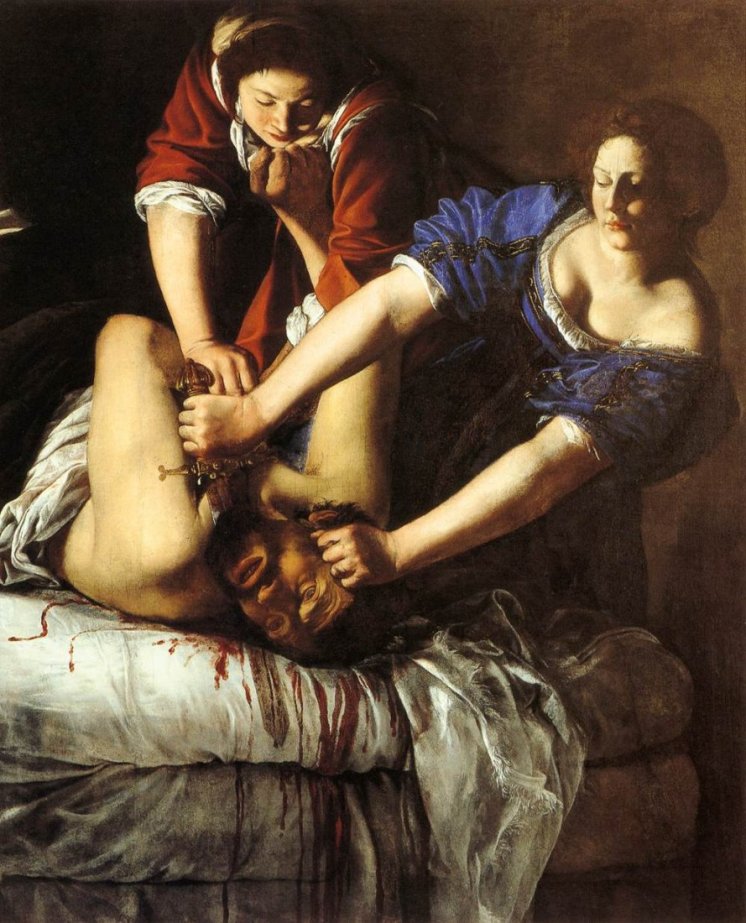
She was also a few hundred years early to the criticism of the male gaze. In Susanna and the Elders (1610), she retells the story of Susanna from the book of Daniel, who as she bathed was watched by two perverts (aka the Elders). Alone and vulnerable, they tell her that unless she had sex with both of them they would accuse her of infidelity – a crime for which she could be sentenced to death. When she refuses she is arrested. She is sentenced, but just before her execution a bloke named Daniel, in typical male fashion, swings in and saves the day.
What makes Artemisia’s painting significant is that it is in her painting alone that Susanna is seen as a victim. Since this scene had only been depicted by men, her passivity and perceived complicity in the voyeurism and attack is striking. It is only Artemisia’s piece that sees the elders for what they are: predators.

Like many ladies of history, her work was ignored, ridiculed and misattributed. She was rediscovered some 30 years ago by fellow feminists who took her out of the dark and saw her work for what it was: extraordinary. The scope of her work is a litany of powerful women reclaiming control and exacting revenge on their male oppressors and abusers. It is all bitterness and spite wrapped up in a timeless talent. Into her work every survivor can pour their stories and be returned with some release.
Anne Bonny (1702 – 1782)
One of the most famous female pirates of all time and the first on our list comes Anne Bonny. You may know her from Black Sails and Assassin’s Creed, but the real life Anne is just as badass (and ruthless).
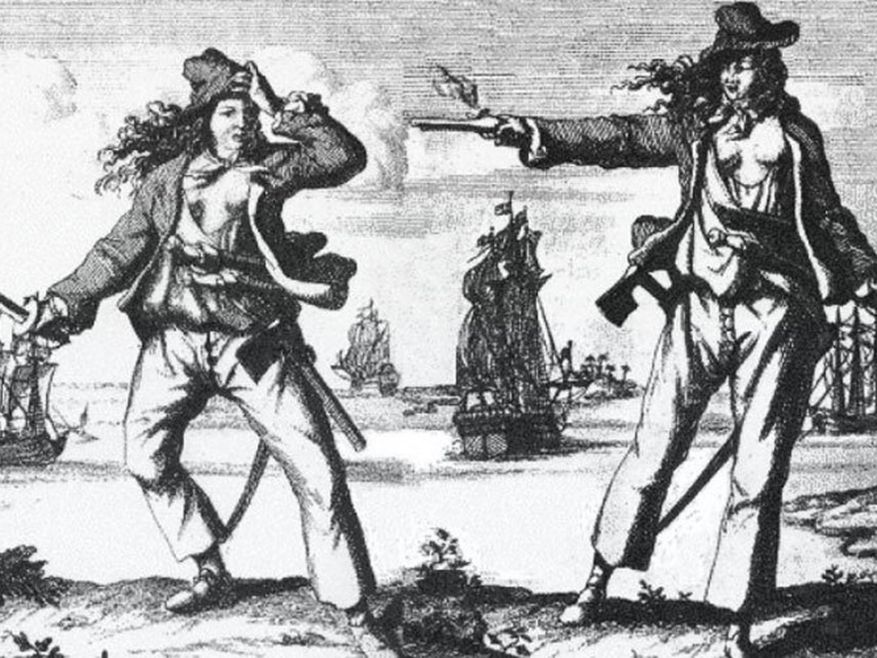
Born the illegitimate daughter of a maid and a lawyer named William Cormac in Cork, Ireland, the scandalous nature of her parents’ affair led them to flee to the New World. While the majority of stories about her during this period are layered in rumour thanks to her infamous reputation as an adult, they do include tales that Artemisia would commend her for – like when she supposedly put a man in hospital for weeks after he tried to sexually assault her.
When she was 16 married small-time buccaneer, James Bonny, who although unremarkable himself, led her to a career that would be remembered for centuries. When her father disowned her over her marriage, she supposedly tried to burn down his plantation in retaliation before travelling with her new beau to New Providence, a pirate’s hideout.
It was here that the trajectory of her life shifted, as she met the equally famous Calico Jack Rackam. Repulsed by her husband’s cowardice for having taken a pardon from the king and fascinated by Rackam, she took to the seas and began her bountiful career as a pirate. At a time when women were considered to be bad luck on a ship, she was made first mate on the vessel whose famous skull and cross bones flag has now become synonymous with pirates.
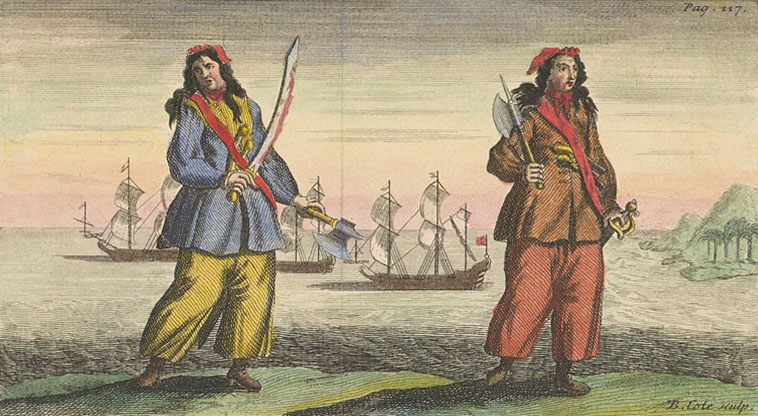
Countless raids later, Mary Read appeared. Now, Mary is a lady who deserves a place of her own on this list, but alas – this is already very long. She began her pirating career by disguising herself as a man and smuggling her way onto a ship. Reports vary about when they actually met, but unsuprisingly, the two women gravitated to each other and are thought to have been lovers. The ruthless women became known as “fierce hell cats” across the Bahamas.
When their ship was commandeered by the British Navy, Mary and Anne were the only ones to fight while the men drunkenly slept below. Once captured, the women used the excuse of pregnancy to escape hanging. Mary died while in jail and Rackam was hung, but Anne, banking on her father’s relation, secured her release, remarried and died an old woman.
Joan of Arc (1412 – 1431)
So I was eight or so the first time I heard of Joan of Arc. I had just had all my hair chopped off because I was a tomboy and ew girls, and so when I rocked up to the playground with my cool new bob and was called Joan of Arc by a boy in my class, I remember being stood there like: “wait, is that supposed to be an insult? I look like the woman who single headedly united the French against the English and lead them to victory? Cool!” Ok well the last bit is made up, but nonetheless, I was confused.
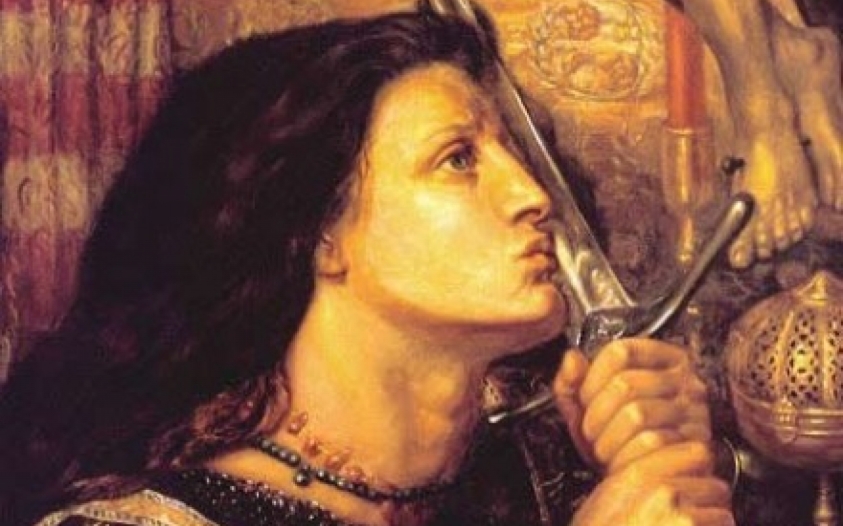
Joan of Arc for those not in the know was a peasant girl from rural France who rose to fame during the Hundred Years War. Despite France being largely dominated by pro-Burgundian lords (aka the fraction backing the Duke of Burgundy) and English people doing what they do best: invading other countries, she helped the monarchy regain control.
Now, the French monarchy was not faring well in their battle for France. However, long had a myth lingered in the region that prophesised that they would be saved by a virgin from “the borders of Lorraine” “who would work miracles.”
Enter Joan stage left. After being called by God to help the monarchy, Joan dressed as a man and headed straight for battle. Joan started seeing visions when she was 13, now these could have been some sign of early mental illness, but seeing angels and gods was much more socially acceptable then than it is now so people dug it. After predicting multiple outcomes and tactics, the men who initially laughed her off suddenly wanted her help and she was given an audience with Charles VII, the would-be ruler of France.
From here, Joan became the Christian figure head needed to unite France and give the war a religious angle that always goes so well. Her presence (and believed divinity) gave the troops the courage needed to see off the enemy and despite being wounded herself, they protected the city and also went on to regain territories such as Reims and Gien.
But the Brits didn’t stay quiet for long. Back with a vengeance and a new ally, together they and the Burgundians attacked Compiègne. She insisted on staying with the troops until she was pulled from her horse and captured by the Burgundians, who then sold her to the English.
Joan was then put on trial for heresy, because obviously only the English could have god on their side. The English tripped over themselves trying to convict her, but even they were astounded that an illiterate peasant could speak so evocatively and intelligently. Nonetheless, they needed to get her for something and that ended up being… cross-dressing?
According to the tribunal members, Joan cross dressing was basically down to her having chosen to wear male military clothing. This was because it gave her the ability to attach her hosen, boots and tunic together into one piece to make raping her more difficult. How dare she, right?
Anyway, spurred on my medieval boredom and madness, they said Joan could only cross-dress if necessity demanded it. Despite cries of “this is the only way I can get you shit bags to leave me alone”, she was sentenced to death by burning at the stake in 1431.

Catherine La Voisin (1640 – 1680)
Fortune teller, midwife, sorceress, connoisseur of poisons and all round b/witch, Catherine La Voisin is less of a badass and more batshit insane. I’ve included this spawn of Satan because history is full of demented and insidious men, yet a malicious woman is still considered a subversion. Gender roles and rigid constructs of just how a woman should behave is part of what makes the depravity of women like her so unnerving. This is an idea that I’ll probably explore in a later blog post, but for now let’s marvel at a woman whose life feels more suited to the pages of a gothic novel than it does reality. Anyway, here she is: all spite and schemes standing tall as a contender as one of the world’s most evil women (and I hesitantly use that term).
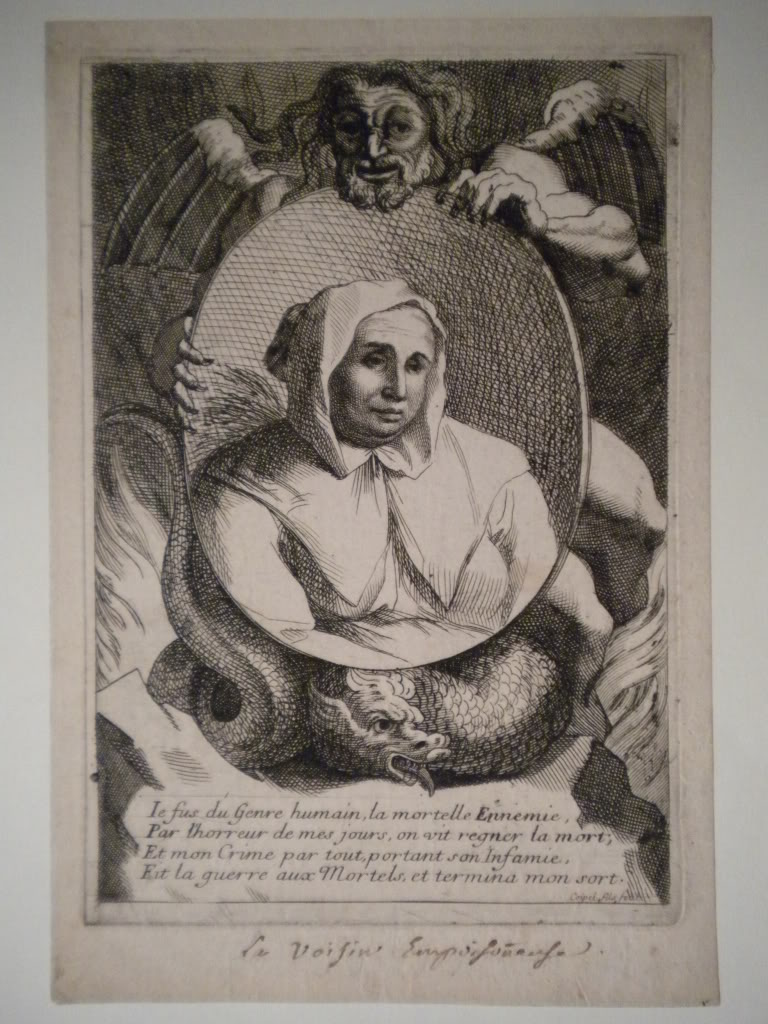
Her story begins after the economic ruin of her husband. La Voisin decided to use her knowledge of fortune telling to start raising money but soon realised that there were far more lucrative services she could provide – like poison. Pragmatic and cunning, La Voisin was a true performer; paying diligent attention to everything from creating a creepy, believable atmosphere to investing in a fabulous crimson red velvet robe with two hundred golden embroidery eagles emblazoned on it.
It was through this work that she gained insight into the hopes, fears and dreams of people who passed through her doors. She realised all they wanted was the love of another, the loss of a pesky partner or the death of a family member standing in the way of an inheritance. Similar to Giulia Tofana (an Italian who like her mother and daughter, made a living through supplying unhappy wives with poisons to do away with their husbands) she started selling aphrodisiacs and poisons. Because, after all, you could go to church to pray, but you could also use a concoction of toads, teeth and human blood to create love potions and venoms.
Then things took a darker turn: she began hosting black masses and Sabbaths where clients could summon and pray to the Devil. With the help of fellow fortune teller Catherine Trianon and other sorcerers and ordained Catholic priests, their ceremonies morphed into a cult known as the Affair of Poisons. Their prayer book was supposedly bound with human skin and their holy water was urine – it was sacrilegious in every sense of the word.
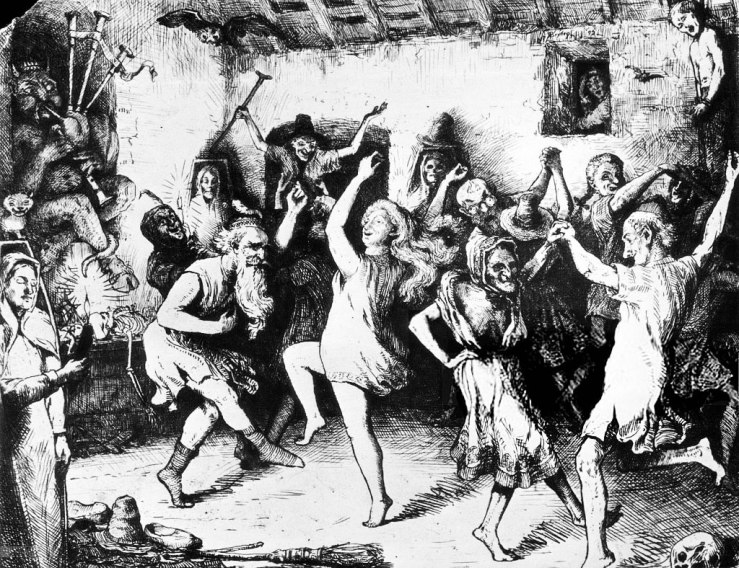
It is thought that they were responsible for thousands of deaths and were rumoured to have performed child sacrifices. She even performed a black mass for Madame de Montespan, King Louis XIV of France’s official royal mistress – later, the two would team up with a network of other conspirators and try to poison him after she feared he would leave her.
When La Voisin wasn’t entertaining guests at her debauched parties or with one of her many lovers – whose occupations ranged from executioners, Satanists to magicians – she was researching alchemy and science. Moreover, La Voisin, for all her faults and thievery, was also a midwife and one of the few people at that time who would perform abortions. She set up a home for unwed mothers, although before we commend her, it’s worth noting she only did so to get access to the babies.
Meanwhile, as her cult practiced dark arts behind the façade of Paris, a riot broke out after Satanists were accused of kidnapping children and using them for sacrifices. Marie Bosse, La Voisin’s arch enemy and competitor, spied a way to get ahead and reported her to the authorities (though she herself would be burnt at the stake in 1679). When officers discovered a carriage waiting outside her church that belonged to King Louis’ mistress, their murder plot was foiled and she was subsequently arrested. Once in prison she began to recall in grim detail the long and vile story of her life and crimes. She was burnt at the stake in 1680, swearing, spitting and singing until the flames engulfed her.
Gráinne Ní Mháille/Grace O’Malley (1530 – 1603)
Last but not least come Grace O’Malley/ Gráinne Ní Mháille. A century before the likes of Anne, Gráinne started the trend when it came to being a badass bitch of the sea. Gráinne, who would become known as the Pirate Queen of Connaught, united the Vikings, Celts, and Scottish Highlanders under one banner and used her bloodthirsty horde to dominate the Irish coastline.
Kings and Queens would eventually bow to her, but her beginnings were humble enough. Her father was the leader of Clan O’Malley whose fleet traded with the likes of Spain, England, France and Portugal. Like him, she craved the sea and was not satisfied to marry and sink into a quiet, inconsequential life.
Her dad tried to dissuade her, but like all the ladies on this list, she was not a woman you could reason with. She soon became known for her keen eye and was respected by the crew, once even saving one of them from a pirate by leaping off the rigging, dive-bombing WWE-style and killing him. So from there, you can imagine the men were pretty cool with her leading.
In 1546 she as married off to a man named Donal O’Flaherty. Now Donal (like many men with names like his) was a bit of a dick. I mean, he lived in a place called Cock Castle, so go figure. Anyway, he managed to annoy enough of his fellow Irishmen to warrant getting murdered, meaning that Gráinne was thrown to the curb. But not for long – she rallied her troops and successfully stormed the castle, renaming it Hen’s Castle (a name that it still has today).
She also married another man, but as her final words to him were “Richard, I dismiss you!” after she changed the castle’s locks, we’ll leave that bit of the story out. Through the death of her father and husbands, she inherited long stretches of coastlines and castles. Once gifted with geographical prominence, she did what any lady would do: built a pirate army.
Now her father had implemented a tax for boats passing through their coastline, but Gráinne upped the price and had boats full of Viking and Scottish Highland warriors (known as Gallowglass) ready to climb aboard the boats of unwilling travellers. Together they raided settlements across Ireland, amassed a huge bounty and just all round annoyed the English. One story tells of how she was once refused entry to an English Earl’s dinner party and so in return, she kidnapped his son and held him for ransom. He was returned once the Earl promised he’d cook her some bacon and keep a plate out for her at every meal for the rest of his life – just in case she ever fancied turning up again.
During the Spanish Armada, one of Spain’s warships got lost on the way and ended up in her stretch of sea. Needless to say she captured the war galleon. The English, rather than rewarding her, decided to launch an attack on Hen’s Castle to quieten the trouble maker for good – instead, she poured vats of boiling hot oil onto the soldiers (a badass and kind of ironic caveat: she used the melted armour to make bullets, which yup, she then used against the English).
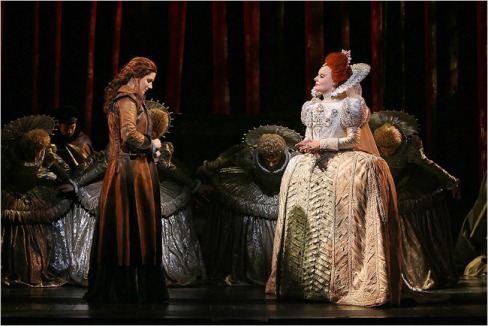
However, she shaped history the most when her brother and sons were captured and held for ransom by the English Governor of Connaught. She responded by demanding an audience with an equally badass bitch of history, Queen Elizabeth. Once there, she refused to speak English, had multiple weapons confiscated and managed to insult just about everyone. Elizabeth, appreciating the presence of another strong lady who refused to take shit from men, agreed to fire the Governor and release her family under the condition that she stop attacking so many settlements in Ireland. Fair trade.
She died an old, rich lady surrounded by toy boys and gold. Not a bad end, eh?
What other medieval ladies would you like to see recognised? Catch the first installment, Badass Bitches of Antiquity, here.


[…] not all witches can be heralded as misunderstood heroes, I mean, just take Catherine La Voisin. I’ve written about her before and have definitely drunkenly ranted about her at length to anyone who would listen (don’t judge […]
LikeLike
Reblogged this on ReBirth: The Pursuit of Porsha.
LikeLike
[…] (Psst: You can find my previous two (historical) versions of the Badass Bitches series here and here). […]
LikeLike